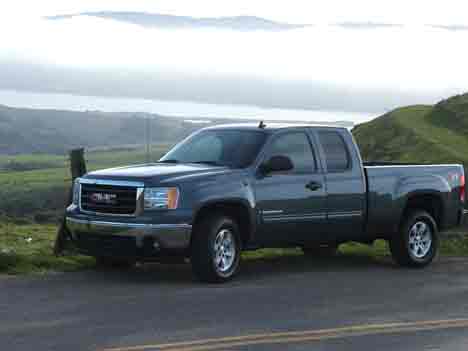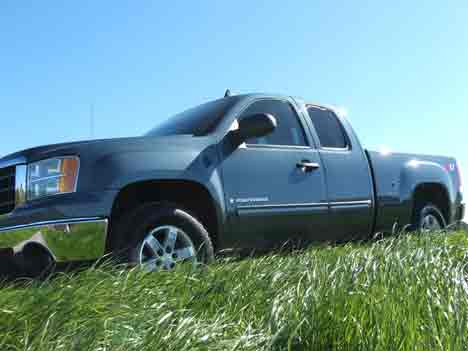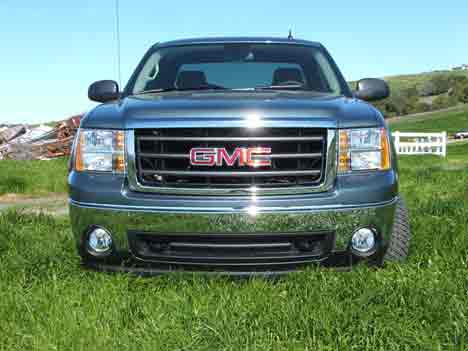Performance Under Pressure: 2007 GMC Sierra 1500 Review
ORC studies specific components of Sierra's rebuild
Like its tougher Chevy Silverado counterpart, the full-size 2007 GMC Sierra has been built on a completely new platform with improvements across the board. This includes all-new styling, performance, engine power, safety, warranty and a luxurious interior.
 |
The Z71 suspension package features monotube front and rear shocks and a 34mm stabilizing bar. Photo by ORC. |
Combined with its mate, the two can outsell its biggest competitor, the Ford F-150 series. As with the Silverado, the Sierra serves as a replacement to the C/K model, which stood for the drive configurations C1500 (with a 2WD) and K1500 (with a 4WD). In 1988, GMC decided to use the term Sierra on all GMC pickup trucks, dropping the usage of C/K altogether the following year.
Wanting to look closer at specific rebuild components, ORC was offered to test-drive a 4WD Sierra 1500 with the Z71 Off-Road Package. Under the hood was the FlexFuel version of the iron 315-horsepower 5.3-liter V8 with 338 lb-ft of torque. This particular Sierra featured the SLE1 trim with an Extended Cab and in Deep Blue Metallic. Total vehicle options, which include (but are not limited to) rear park assist, the SLE1 preferred and audio package, StabiliTrak and trailering package, put the final vehicle price at $34,635.
 |
Like its tougher Chevy Silverado counterpart, the full-size 2007 GMC Sierra has been built on a completely new platform. Photo by ORC.. |
SIERRA STAND-OUTS
With improvements in over six key product areas, I wanted to begin with the most notable and consumer-desired performance change – GMC’s decision to replace the previous model’s torsion bar with a new coil-over shock-front suspension. I started out by taking the Sierra on some poorly conditioned roads; you know, those decrepit ones the city tries to forget need repair. There was no jostling but a great on-center feel when hitting the towered asphalt patches and ugly pockmarks.
The Sierra headed high into the Northern California hills to a private ranch property for minor off-road groveling in mud, sand and gravel conditions. The Z71 suspension package, one choice among five, features specific monotube front and rear shocks and a 34mm stabilizing bar. Sudden and unpredictable dips and changes in the ranch landscape were quickly absorbed with smoothness. On flat surfaces where the grass was too tall and lush to see if small boulders lined my path, I knew anything kicked up would be protected by the skid plate package.
This is when I got to try the improved automatic locking rear differentials, which take hold under slower speeds. Power was immediately transferred to the wheel with grip when a loss of traction was detected. In-and-out you’d go in compromising situations, wondering if you had ever been in one. The 4WD is available with a push of a button.
Since February saw its share of sever weather, and I was fortunate to take the Sierra on a single-lane highway under extremely windy (yet dry) conditions to test aerodynamics. The 57-degree windshield angle definitely reduced wind noise and the body frame held steady. It’s also this widen and lowered new stance to the redesigned frame that adds this kind of security.
 |
ORC test-drove the Sierra on private ranch property for some off-road groveling in mud, sand and grass. Photo ORC |
The 5.3-liter V8 engine features GM's new Active Fuel Management (AFM) system, which can deactivate half the eight cylinders and smoothly put the engine into V4 mode during low-load driving. You are informed though digital readings on the dash when the engine switches cylinder modes. It reverts back-and-forth quite frequently. GMC claims a highway fuel economy of better than 20 miles per gallon with their Active Fuel Management system. According to EPA calculations, this saves owners $1,010 to $2,037 in annual fuel costs. I also thought the upgraded Hydra-Matic automatic transmission did shift very quietly.
What I really loved about the Sierra is how it took turns with absolutely no body roll. The tires remained firmly planted at all times and speeds. I took greater and greater pleasure tackling those unpredictable curves on coastal and rural roads. The Sierra hugged on-and-off ramps of all shapes and challenges, and I sat in that vehicle comfortable and with assurance of its capability.
 |
The 2007 Sierra shows off its redesigned front end, hood, and headlight modules. Photo by ORC |
INTERIOR & EXTERIOR PLUSES
I didn’t feel like I was in a full-size truck, which is a good thing for me. Turning into and backing out of tight parking quarters didn’t make me feel like a little kid behind the wheel of a monster truck. I had the Ultrasonic Rear Parking Assist to rely on, anyway, which beeped when I was coming too close to an object. On Extended Cab models such as this one, there is a new rear access door with a 170-degree extension – wider than any other full-size truck. I definitely loved this loading up groceries, as did parked neighbors who could ease past me and into their vehicles. In general, taking a full-ton pickup truck to a tiny and crowded shopping center took on a new meaning.
As far as the interior, the dashboard lights up like a Christmas tree at night, technology calling out to you from every angle. I didn’t care for the styling of the gauges, which were too reminiscent of a sports car and finished with fake (okay, plastic) chrome. The sound of the blinker was a bit annoying. It definitely has a luxury-inspired interior with its leather seats and other distinct trim. There was also a heated, 12-way power-adjustable driver’s seat, a Bose speaker system and heated windshield washer system.
For the exterior, the Sierra is available in several trim packages, including work truck (WT), SLE (in a SLE1 and a SLE2) and SLT with 2WD and 4WD configurations and three cab styles. The Sierra has a redesigned front end and rear, hood, and headlight modules. To the untrained eye, the most obvious difference between the Sierra and the Silverado is the grille. Whereas the Silverado features three bars and the Chevy bowtie insignia, the Sierra has a very prominent GMC emblem set in a chrome-ringed grille. I also liked the fact the rear wheel flared just enough to enhance a muscular look. No woman is a fan of big hips.
 |
A very prominent GMC emblem set in the chrome-ringed grille. Photo by ORC |
TORN BETWEEN TWO OPTIONS
Overall, the Sierra is an extremely comfortable and confident drive, especially in that high-class luxury Extended Cab with all its leather and technology. There isn’t’ much difference between the Sierra and the Silverado in terms of performance, options, and a few interior details (the Sierra is more luxurious). So if the Sierra won me over, which it did, so did the Silverado.
The only arrangement that I could say provoked my security was a somewhat-typical blind side on the driver’s right – no view is allotted when you turn your neck to scan for creeping traffic before switching lanes. Sure, the side mirrors were wide enough to accommodate angles. Call me behind the times for wanting this manual option, but you are simply – for better or for worse – forced to rely on the technology of this vehicle. I think the 2007 GMC Sierra could convince me to modernize this opinion, because I was beginning to trust its abilities completely.
.


 Your Privacy Choices
Your Privacy Choices